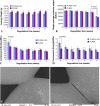Nano-ceramic composite scaffolds for bioreactor-based bone engineering
- PMID: 23436161
- PMCID: PMC3705070
- DOI: 10.1007/s11999-013-2859-0
Nano-ceramic composite scaffolds for bioreactor-based bone engineering
Abstract
Background: Composites of biodegradable polymers and bioactive ceramics are candidates for tissue-engineered scaffolds that closely match the properties of bone. We previously developed a porous, three-dimensional poly (D,L-lactide-co-glycolide) (PLAGA)/nanohydroxyapatite (n-HA) scaffold as a potential bone tissue engineering matrix suitable for high-aspect ratio vessel (HARV) bioreactor applications. However, the physical and cellular properties of this scaffold are unknown. The present study aims to evaluate the effect of n-HA in modulating PLAGA scaffold properties and human mesenchymal stem cell (HMSC) responses in a HARV bioreactor.
Questions/purposes: By comparing PLAGA/n-HA and PLAGA scaffolds, we asked whether incorporation of n-HA (1) accelerates scaffold degradation and compromises mechanical integrity; (2) promotes HMSC proliferation and differentiation; and (3) enhances HMSC mineralization when cultured in HARV bioreactors.
Methods: PLAGA/n-HA scaffolds (total number = 48) were loaded into HARV bioreactors for 6 weeks and monitored for mass, molecular weight, mechanical, and morphological changes. HMSCs were seeded on PLAGA/n-HA scaffolds (total number = 38) and cultured in HARV bioreactors for 28 days. Cell migration, proliferation, osteogenic differentiation, and mineralization were characterized at four selected time points. The same amount of PLAGA scaffolds were used as controls.
Results: The incorporation of n-HA did not alter the scaffold degradation pattern. PLAGA/n-HA scaffolds maintained their mechanical integrity throughout the 6 weeks in the dynamic culture environment. HMSCs seeded on PLAGA/n-HA scaffolds showed elevated proliferation, expression of osteogenic phenotypic markers, and mineral deposition as compared with cells seeded on PLAGA scaffolds. HMSCs migrated into the scaffold center with nearly uniform cell and extracellular matrix distribution in the scaffold interior.
Conclusions: The combination of PLAGA/n-HA scaffolds with HMSCs in HARV bioreactors may allow for the generation of engineered bone tissue.
Clinical relevance: In cases of large bone voids (such as bone cancer), tissue-engineered constructs may provide alternatives to traditional bone grafts by culturing patients' own MSCs with PLAGA/n-HA scaffolds in a HARV culture system.
Figures







Comment in
-
Editor's Spotlight/Take 5: Nano-ceramic composite scaffolds for bioreactor-based bone engineering.Clin Orthop Relat Res. 2013 Aug;471(8):2419-21. doi: 10.1007/s11999-013-3094-4. Epub 2013 Jun 8. Clin Orthop Relat Res. 2013. PMID: 23749432 Free PMC article. No abstract available.
Similar articles
-
Fabrication, characterization, and in vitro evaluation of poly(lactic acid glycolic acid)/nano-hydroxyapatite composite microsphere-based scaffolds for bone tissue engineering in rotating bioreactors.J Biomed Mater Res A. 2009 Dec;91(3):679-91. doi: 10.1002/jbm.a.32302. J Biomed Mater Res A. 2009. PMID: 19030184
-
Editor's Spotlight/Take 5: Nano-ceramic composite scaffolds for bioreactor-based bone engineering.Clin Orthop Relat Res. 2013 Aug;471(8):2419-21. doi: 10.1007/s11999-013-3094-4. Epub 2013 Jun 8. Clin Orthop Relat Res. 2013. PMID: 23749432 Free PMC article. No abstract available.
-
Polymer-ceramic composite scaffold induces osteogenic differentiation of human mesenchymal stem cells.Conf Proc IEEE Eng Med Biol Soc. 2006;2006:2651-4. doi: 10.1109/IEMBS.2006.259459. Conf Proc IEEE Eng Med Biol Soc. 2006. PMID: 17946970
-
Modulation of cell differentiation in bone tissue engineering constructs cultured in a bioreactor.Adv Exp Med Biol. 2006;585:225-41. doi: 10.1007/978-0-387-34133-0_16. Adv Exp Med Biol. 2006. PMID: 17120788 Review.
-
An overview of poly(lactic-co-glycolic) acid (PLGA)-based biomaterials for bone tissue engineering.Int J Mol Sci. 2014 Feb 28;15(3):3640-59. doi: 10.3390/ijms15033640. Int J Mol Sci. 2014. PMID: 24590126 Free PMC article. Review.
Cited by
-
Aminated Graphene-Graft-Oligo(Glutamic Acid) /Poly(ε-Caprolactone) Composites: Preparation, Characterization and Biological Evaluation.Polymers (Basel). 2021 Aug 7;13(16):2628. doi: 10.3390/polym13162628. Polymers (Basel). 2021. PMID: 34451168 Free PMC article.
-
In Vitro Physico-Chemical Characterization and Standardized In Vivo Evaluation of Biocompatibility of a New Synthetic Membrane for Guided Bone Regeneration.Materials (Basel). 2019 Apr 11;12(7):1186. doi: 10.3390/ma12071186. Materials (Basel). 2019. PMID: 30978950 Free PMC article.
-
In Vitro Study of Surface Modified Poly(ethylene glycol)-Impregnated Sintered Bovine Bone Scaffolds on Human Fibroblast Cells.Sci Rep. 2015 May 7;5:9806. doi: 10.1038/srep09806. Sci Rep. 2015. PMID: 25950377 Free PMC article.
-
Recent Advances in Hydroxyapatite Scaffolds Containing Mesenchymal Stem Cells.Stem Cells Int. 2015;2015:305217. doi: 10.1155/2015/305217. Epub 2015 May 28. Stem Cells Int. 2015. PMID: 26106425 Free PMC article. Review.
-
[Research status and progress of biomaterials for bone repair and reconstruction].Zhongguo Xiu Fu Chong Jian Wai Ke Za Zhi. 2018 Jul 15;32(7):815-820. doi: 10.7507/1002-1892.201806028. Zhongguo Xiu Fu Chong Jian Wai Ke Za Zhi. 2018. PMID: 30129301 Free PMC article. Chinese.
References
-
- Berrey B, Lord C, Gebhardt M, Mankin H. Fractures of allografts. Frequency, treatment, and end-results. J Bone Joint Surg Am. 1990;72:825–833. - PubMed
Publication types
MeSH terms
Substances
LinkOut - more resources
Full Text Sources
Other Literature Sources
Research Materials

